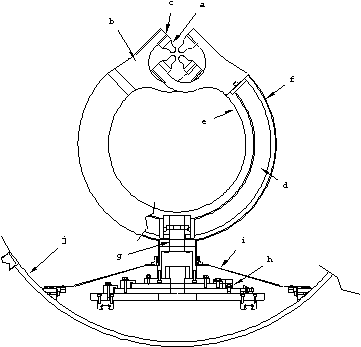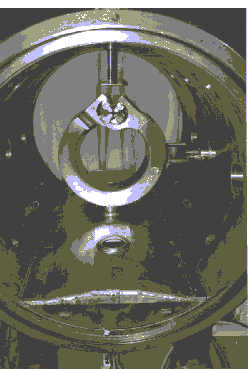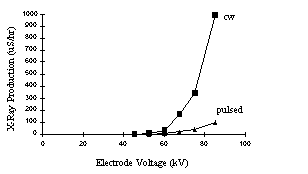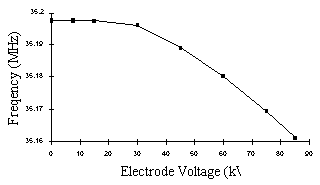The ISAC radioactive ion beams facility being built
at TRIUMF requires cw operation of a low frequency RFQ structure.
This implies a large structure with adequate cooling while still
maintaining mechanical alignment and stability. Our goal is to
achieve a thermal stability alignment of +/-0.08 mm along the
entire length of the RFQ structure and a dynamic stability of
the operating assembled RFQ structure, taking into account deformation
due to thermal drifts and vibrations induced by cooling and vacuum
pumps, to within +/- 0.025 mm. Cold model studies [1] have been
carried out to confirm the RF characteristics of the RFQ design.
To confirm the manufacturability of the design to maintain the
above tolerances, a prototype section consisting of three RFQ
rings is being fabricated and will be tested to full cw power
(85 kV between electrodes). The basic design of the structure
is different from other RFQ structures in that the RF surfaces
have been de-coupled from the mechanical support structure for
improved stability. The features of this mechanical design will
be discussed and the first results of the RFQ prototype tests
will be presented.
The accelerating system of the ISAC radioactive ion
beams facility consists of an RFQ and a post -stripper DTL. Singly
charged ion beams with A < 30, delivered from the on
line mass separator with an energy of 2 keV/u, will be accelerated
to 150 keV/u through the RFQ and then to a maximum energy of 1.5
MeV/u through the DTL structure. The low charge-to-mass ratio
of the ions dictate a low operating frequency to achieve adequate
transverse focusing, and cw operation is required to preserve
beam intensity. The reference design [2] for the RFQ is a four
rod split ring structure operating cw at 35 MHz with 85 kV potential
between the electrodes. The RFQ accelerator section is 8 meters
long and is designed in 40 cm long modules. To confirm the manufacturability
of the design to maintain the tight tolerances, an RFQ prototype
section consisting of three such modules is being fabricated but
initial measurements are made on a single module.
Figure 1 is a sketch of one module with the major
components identified. The basic design of the structure is different
from other RFQ structures in that the water cooled RF skin has
been de-coupled from the mechanical support structure (strongback)
for improved mechanical stability. This design feature introduces
an additional joint across the RF current path at the interface
of the electrode supports and the RF skin in which special care
must be taken to provide a good RF contact. The first module uses
an indium gasket and a groove is provided for fingerstock contacts.
Electrodes
The electrodes (Fig. 1a) are machined from Tellurium copper which has an electrical conductivity of 93%. The electrodes are 40 cm long with a tip radius of 8.61 mm. The cross section of the electrode is shaped to provide the proper tip capacity and sufficient room for cooling channels. Two additional sample electrodes were successfully machined with the injection and extraction modulations incorporated into the tip radius.

Electrode Supports
Tellurium copper was not readily available in the
size required for the electrode supports (Fig. 1b) and were therefore
NC machined from chromium copper which has an electrical conductivity
of 80%. The electrode supports were complicated by a non-uniform
tapered shape to maintain the optimum structure design for maximum
shunt impedance and the desire to have three separate cooling
circuits (electrodes, electrode supports, RF skin) in the prototype
to measure the power distribution in the RFQ module. Provision
has been made for shimming (Fig. 1c) the electrodes with respect
to the electrode supports.
Strongback
The purpose of the strongback (Fig. 1d) is to provide
the mechanical stability of the RFQ structure. For the prototype
it was more expedient to fabricate it from aluminum but for the
accelerator system it could be fabricated from carbon steel to
provide added mechanical stability if necessary. The cross-section
is 7.0 cm wide and a radial thickness of 4.5 cm. The outer radius
of the strongback ring is 22 cm.
RF Skin
The RF skin is fabricated from standard copper sheet.
The inner RF skin (Fig. 1e) includes the side surfaces of the
ring, giving it a U shaped cross-section 15 cm wide and 8 cm deep
with an outer radius of 26 cm. An initial attempt to spin it from
one piece of copper failed and was subsequently fabricated from
three separate pieces of copper with welded joints at a radius
of 19 cm on each side surface. Since the joint is in the direction
of the current flow, the effect should be minimal on the losses.
To ease the fabrication process the wall thickness was increased
from 2.5 mm to 5 mm with the consequence of producing a much stiffer
RF skin structure than initially planned. In the meantime we were
successful in finding a manufacturer who was successful in spinning
the RF skin from one piece of 1.75 mm thick copper sheet and the
second RFQ module will incorporate this RF skin and enable us
to compare the two designs. The inside surface of the RF skin
is water cooled. The outer RF skin (Fig. 1f) is a simple flat
copper strip 15 cm wide shaped to the outer radius of the inner
RF skin with an extension at the bottom to cover the stem.
Stem and Base Plate Assembly
The stem (Fig. 1g) is fabricated from mild steel in two sections and is nickel plated to prevent any rusting. Its main purpose is to support the weight of the RFQ structure in its proper position and provide access for the water cooling circuits.
The base plate assembly (Fig. 1h) for the RFQ prototype
allows for 6 degrees of adjustment in order to have better control
of the alignment for measuring misalignment effects on the RF
field. The base plate assembly for the accelerator system will
be greatly simplified.
RF Skirt
The RF skirt (Fig. 1i) shields the base plate assembly and linear bearings from the RF fields. It is fabricated from standard copper sheet with finger contact at the stem and the vacuum tank wall.
Vacuum Tank
The vacuum tank (Fig. 1j) is fabricated from copper
plated mild steel with an inner diameter of 104 cm. Unfortunately
a 30 cm wide strip at the top of the tank did not get copper plated
and the quality of the copper plating on the rest of the tank
was very poor. Also the RFQ design was based on a tank diameter
of 120 cm. Both these errors will increase the RF losses in the
tank wall for the prototype system.
Figure 2 is a photograph of the first ring installed
in the vacuum tank. In order to obtain preliminary measurements
the electrodes were aligned to only +/- 0.250 mm but the average
alignment (i.e., electrode tip capacitance) was within the +/-
0.08 mm tolerance.

Signal Level Measurements
The frequency was measured to be 35.186 MHz compared
to the design value of a nominal 35 MHz. Although MAFIA predicted
a Q as high as 14000 for the single ring the maximum Q measured
was 7200. Improving the RF contacts at the interface of the electrode/electrode
support or the electrode support/RF skin did not improve the Q.
Mafia predicted an R/Q of 71 ohms compared to a measured R/Q of
60.4 ohms A shunt impedance of 435 kilohms was derived from the
measured values of Q and R/Q which gives a power requirement of
8.3 kW for 85 kV at the electrodes.
Power Level Measurements
Without the RFQ module installed, the tank vacuum
was 4 x 10-7 torr. With the RFQ module installed, following several
days of pumping, leak checking and bakeout, a vacuum of 1.2 x
10-6 torr was reached. By the end of two weeks of power level
measurements the base vacuum was 6 x 10-7 torr and 9.5 x 10-7
torr with RF on. Full voltage was reached in 8 hours with only
two minor problems; heating on the top of the vacuum tank where
the copper plating was missing and production of x-rays from the
walls of the ports where the material is thinner than the tank
wall. A water cooling saddle was installed on the top of the tank
and the port walls were wrapped with lead shielding to attenuate
the x-ray radiation to acceptable working levels. A graph of the
X-ray production near the window port as a function of electrode
voltage is shown in Figure 3 for both cw and 20% duty cycle operation.

The voltage at the gap was determined by measuring the energy of the x-rays produced and gave a power requirement of 8.0 kW for 85 kV at the electrodes, which is in very good agreement with the signal level measurement and calculation of 8.3 kW.
Thermocouples and water flow meters were installed
on the return lines of the cooling circuit for the electrodes,
electrode supports and RF skin. The remaining power was assumed
to be dissipated in the vacuum tank wall. With proper copper plating
and increased tank diameter for the actual RFQ accelerator system,
the tank wall losses are expected to be much less. Table 1 is
a summary of the RF power distribution.
Table 1 - RF Power distribution
for the RFQ module
| Skin | ||
| Electrode Support | ||
| Electrode | ||
| Tank wall | ||
| Total |
The frequency of the RFQ decreases by 36 kHz from
signal level to full power (see figure 4). The thermal movement
of the electrodes from signal level to full power was measured
by observing the position of the electrodes with a theodolite.
A movement of less than +/- 0.050 mm was observed when the voltage
was slowly increased to 85 kV and no dynamic movement (< +/-
0.25 mm) was observed due to cooling water or vacuum pumps. When
the voltage was instantaneously applied a movement of approximately
0.200 mm was observed by each pair of the same polarity electrodes
in the direction away from the beam centre, but returned to its
aligned position within three minutes.

The effect of slowly shutting off the water cooling
to the electrodes was a decrease in frequency of 18 kHz with no
observable movement of the electrodes.
Despite the design changes which had to be incorporated for manufacturability, the design feature of de-coupling the water cooled RF skin of the ring from the mechanical strongback structure was successfully fabricated and a stable RFQ module was produced. Our thermal and dynamic stability tolerances of +/- 0.08 mm and +/- 0.0250 were achieved. The RF specifications of 85 kV between electrodes at 35 MHz was also achieved.
Plans are already in progress to simplify the RFQ
design to reduce the cost.
There are many people who helped to achieve the above
results. A special thanks to Bill Uzat who designed and built
the RF amplifier, Bhalwinder Waraich, Peter Harmer and John Tanguay
who did a tremendous job with the mechanical assembly and Vijay
Verma who was a tremendous help in scheduling, planning and expediting.
[1] P.G. Bricault, Dave Joffe and H.R. Schneider, "RFQ Cold Model Studies", Proc. 1995 Particle Accelerator Conf. and Int. Conf. on High-Energy Accelerators, p1122 (1995)
[2] P.G. Bricault and H. R. Schneider, "Simulation of the TRIUMF Split Ring 4-Rod RFQ with MAFIA", Proc. 1995 Particle Accelerator Conf. and Int. Conf. on High-Energy Accelerators, p1125 (1995)